regions:
| | 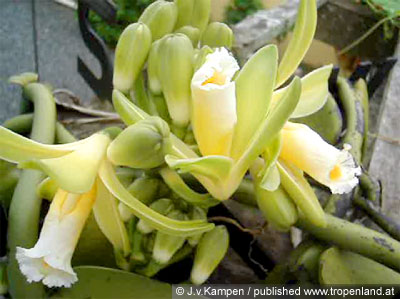 for the coveted pods are the flowers of Hand-pollinated. |
Growth:
Manually pollination:
pierce Using a stick, a pin or similar to the hymen of the flower. It lies between the male pollen and female stigma package. Then press each other pollen and stigmas. Pollination you should clock leader between 6 und 12 clock, then you get the best results.
| | |
location:
| summer | As in nature needs us too vanilla for something where they can grow up. It offers itself to the use of a vertical branch or trunk that is miteingegraben into the earth. You can also use a plastic pipe or the like and wrap it with coconut fibers. In her home growing vanilla in sheltered, partially shaded, humid locations. Consequently she feels at ease in a warm house. You like it when it daily with warm Water is sprayed. In the summer you say, for slight shading to high temperatures. |
| Winter | in winter can drop the temperature to about 15 ° C. However, it is a dry root ball must be ensured. Entertainment room are not ideal for the vanilla, as the humidity should be 75% or more. Such high humidity is not achieved, especially in winter. |
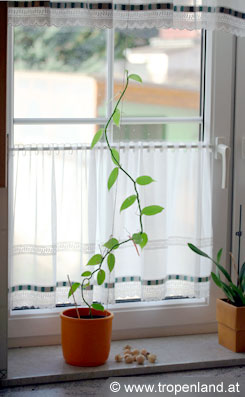 A good location for the vanilla is a bright window with no direct sunlight. | 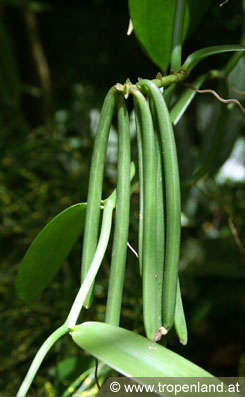 The fruit of the vanilla are rather inconspicuous and are often not perceived. |
cultivation / propagation:
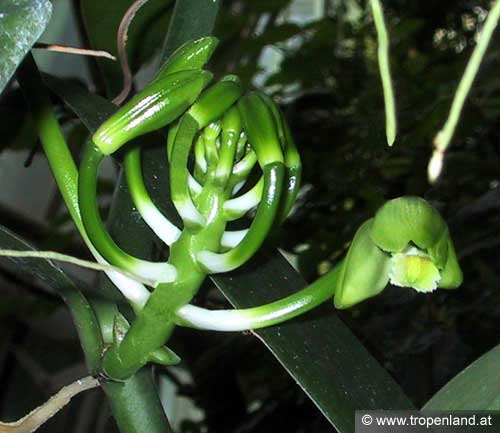 buds of vanilla, right opens the first flower. | |
substrate:
| | |
casting:
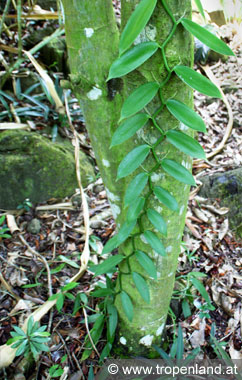 Vanilla is a climbing plant belonging to the family of the Orchid Family. | 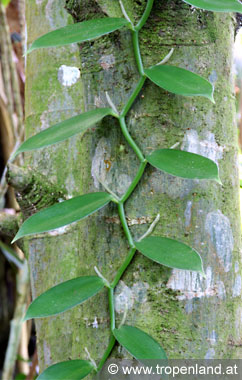 If possible can you put the vanilla in the house a branch available. As the natural habitat they use it as a climbing frame. |
fertilizing:
| | |
fruiting / harvesting:
| | 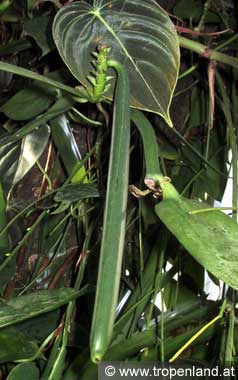 Ripening fruit, greenhouse (Austria) |
fruit use: The fruit
The vanillin is bound to the harvest of glucose. It is Vanillosid (a glucoside). The fruits have therefore at this stage, no vanilla flavor. By a fairly expensive treatment you get the desired flavor.
step 1 "killing": dipping the fruit in hot water (65-70 ° C) for 2 to 3 minutes, "kill" the fruit, and forestall the spread of vegetative processes.
Step 2 "fermentation" let ferment for 1-2 weeks in moist, warm environment. This effect can, for example, by wrapping in wet towels and place on a warm heating. The fruits are beginning to brown and shrivel, thereby to form the glucoside is split by vanillin. The formation of vanillin is visible through the formation of white crystals.
Step 3 "drying" Now the fruits are dried in the shade, which can take 2-3 months. You can also do this slowly and carefully carried out in the oven or on the heating (45-50 ° C). But even in the oven, it takes a long time.
Step 4 "storage" After drying, the vanilla or stored for about 3 months, meaning it develops its final flavor.
Because of the manual pollination and the long manufacturing process is the vanilla one of the most expensive spices. It is mainly in the food industry used as a flavoring, but also it is used for perfume. Synthetically produced vanillin smell but very similar to the vanilla capsule, but lacks many of the accompanying substances of the fruit. This allows the artificially produced vanillin does not replace the fruit in many areas.
| | |
| | |
genus Info:
Vanilla pompona  | called Guadeloupe vanilla or Antilles. (West Indies) |
Vanilla tahitensis  | Probably a hybrid between V. planifolia and V. pompona is. (Tahiti) |
Vanilla babelata  | |
Vanilla roscheri  | |
| | |
| | |
0 comments:
Post a Comment